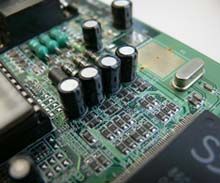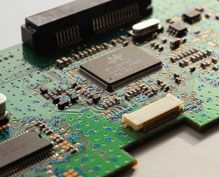
The electrical and electronic components (EEC) sector is an up-and-coming sector for Sri Lanka, with the potential to stimulate innovation, research and development (R&D) and investment in the country. The EEC sector is well positioned to benefit from the electronic and electrical component industry’s steadily increasing levels of manufacturing in Asia, and can contribute to the diversification and technological upgrading of Sri Lanka’s exports.
Globally, the electronics industry has grown from US$1.75 trillion in 2008 to US$2.1 trillion in 2015, and is estimated to grow to US$2.4 trillion by 2020. During the past two decades, the industry – which encompasses consumer appliances, information and communication technology, industrial electronics, aerospace and defence – has experienced a steady expansion that has been driven by both demand and industrial infrastructure. The exponential growth of the Internet and its use for both personal and business data management and communications continues to be the sector’s main driver.
Despite the immense global growth in the electronics industry, Sri Lanka so far has had limited participation in the sector. The country has great potential to develop a competitive electronics industry thanks to skilled labour, relatively well-developed infrastructure and preferential access to key destination markets through trade agreements. Interestingly, the compound annual growth rate (CAGR) for the electronics industry between 2012 and 2016 was 2.57% for Sri Lanka, while the global CAGR was -1.20%.
Electronics is a highly dynamic, globalized industry in which change is a constant; adaptations and upgrades continue to be key enablers and disruptors for the industry. Many trends that evolve from the EEC sector are linked closely with the software and hardware sectors. The main trends are ‘digitization’, ‘automation’, ‘miniaturization’ and, importantly, affordability. Nothing will remain untouched by electronics, in which hardware and software combinations as embedded technologies will continue to deliver disruptive solutions at more affordable prices at an even faster pace.
Several new areas such as security, healthcare, transportation, defence, agriculture, lighting and lifestyles are being digitized and automated at various levels.
This sectoral Strategy under the National Export Strategy (NES) is endorsed and budgeted by the government of Sri Lanka to provide a focused path for the sector to move forward in a way similar to this sector in other countries in the region that have the support of their government. The endorsement of and budget for this Strategy provide the support to guide the sector towards strategic growth in terms of technology, investments and employment generation.
Many rounds of consultations with public and private stakeholders were held in Colombo and regions across the country to understand the sector, and many issues were highlighted in the value chain. This Strategy targets issues affecting the value chain and makes an informed selection of the most important targets that need to be addressed. Two main criteria were used to assess importance: the level of disturbance (perceived by national stakeholders) and the ease of resolution (both in terms of cost and time involved). The following are the most pressing issues that need to be addressed:
Based on trends in the fast-changing EEC sector and on the successful experiences in this sector of neighbouring countries, certain issues must be prioritized. The government of Sri Lanka needs to focus attention on the EEC sector and play a proactive role by taking the following actions:
Three main approaches could make the EEC sector successful in the next five years. First, leverage the country’s existing capacity in Electronics Manufacturing Services (EMS) while increasing production of electrical parts and products. Second, work to become a component manufacturing base for large multinational brands by linking with the software industry, thus helping Sri Lankan producers to move up the value chain. Finally, leverage innovative ideas available in academia and industry to focus on a few high-tech products such as robotics or Internet of Things devices (IoT), among other growth opportunities.
EMS: EEC manufacturers in the country serve as contract manufacturers for a variety of companies from Japan, Scandinavia and the United Kingdom of Great Britain and Northern Island, manufacturing auto electronic parts, batteries and small medical equipment, among other products. The country can attract low-hanging opportunities with a two-pronged approach. First, manufacture high volume but low value products such as LEDs, miniature circuit breakers (MCBs) and electrical switches for companies from China, Japan, the Republic of Korea and Chinese Taipei; and, second, manufacture high value, low volume products such as smart panels, smart energy meters, energy efficiency products and small medical equipment for contracts from Sweden, Denmark, Finland and Germany. Besides the existing electrical products already manufactured in Sri Lanka such as switches, sockets, switch gears and wires, among others, producers can consider manufacturing smart panels, inverters and low power uninterrupted power supply (UPS) units and, if government aggregation support is provided, LED lighting as well. There is already a production base for LED batteries, so linking this to production of inverters and low power UPS units will be a natural step up the value chain. Products such as LEDs and settop boxes would not only help exports but could also supply domestic markets
The strength of Sri Lanka’s manufacture of existing products such as panels, electric meters and wiring harnesses and cables, combined with its strong production capacities for emerging products, switches and MCBs would make manufacturing products such as smart panels for export a natural next step. This could lead to local companies being able to execute medium to large scale projects internationally, thus moving up the value chain. India could provide partners for electrical parts and products manufacturing. Indian companies are looking for alternative destinations to manufacture these products in order to increase trade with Africa and the Middle East. With Sri Lanka’s existing manufacturing strengths, it should be possible to attract Indian investment in Sri Lankan manufacturing for the African and Middle Eastern markets.
Component manufacturing base: Once the country is an EMS destination, the next step would be to manufacture components in Sri Lanka. Among the current products the industry can concentrate on are transformers, capacitors and wiring harnesses, and the range could be deepened by producing cable connectors, PCBs and relays. The latter products have low capital requirements but demand a high labour input. Countries in which to approach companies for such contracts would include Japan, the Republic of Korea and Germany. Such approaches should be supported by setting up a cluster for component manufacturers.
While undertaking initiatives to become a component manufacturing base, consideration also should be given to manufacturing passive and electromechanical components first, since active component manufacturing has high costs and presents technology challenges. Sri Lankan companies already manufacture passive components such 3 as films and transformers; electrolytic and ceramic capacitors and resistors also could be manufactured. In the electromechanical space, Sri Lankan manufacturers already produce wiring harnesses and cables and connectors and relays could be added. Successfully manufacturing these products can strengthen opportunities to become an EMS hub as well.
Globally, manufacturers in high-cost locations such as Japan, the EU (especially Germany) and the United Kingdom are actively looking for an alternative China+1 location. Mostly large multinationals, these companies could be invited to relocate to Sri Lanka to meet their China+1 requirement. This can be achieved by encouraging companies from the Republic of Korea, Japan, Germany and other European countries to establish themselves in Sri Lanka.
Innovations through academia and industry: Entrepreneurs should be encouraged to develop and commercialize innovative designs and products that have been invented by Sri Lanka’s academic institutions and industry, specifically low-cost, high-tech products such as robotics, three dimensional (3D) manufacturing, e-surveillance security devices and IoT devices.
The development of the EEC sector depends significantly on the functions and roles of trade and investment support institutions and on overall inter-institutional coordination. These institutions are divided into four main categories: policy support, trade support, business support, and academia and civil society. They are the drivers for future EEC industry growth but certain capacity and resource issues must be addressed to ensure their effectiveness. The adjustments that can be made to directly benefit the sector are:
The following investments in the value chain are key areas on which to focus in order to achieve a positive outcome for the EEC sector:

